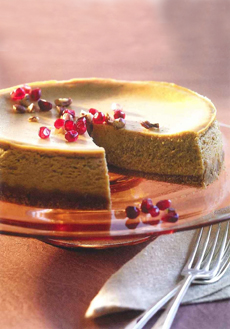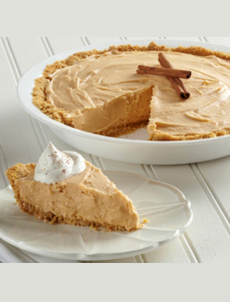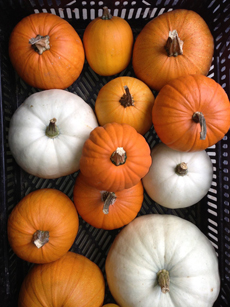Pumpkin Cheesecake Recipes & Pumpkin History
|
|
October 21st is National Pumpkin Cheesecake Day. Here’s the history of cheesecake. The history of pumpkins is below. With Halloween in 10 days and Thanksgiving and Christmas following (sooner than we’d like), it’s perfect timing. There are different styles of pumpkin cheesecake, from the dense New York style with two pounds of cream cheese to a lighter ricotta cheesecake, to pumpkin mousse cheesecake. Here are some recipes from our collection. > The year’s 16 cheesecake holidays. > The year’s 8 pumpkin holidays are below. Don’t want cake? How about some pumpkin cheesecake ice cream? Many pumpkin cheesecake recipes do not include cream cheese, relying simply on the cream and spices to simulate cheesecake flavors. Ben & Jerry’s sells a perfectly charming Pumpkin Cheesecake Ice Cream. But this recipe, from Taste Of Home, is the real deal with cream cheese and egg yolks, just like a cheesecake. Ingredients 1. HEAT 1-1/2 cups cream, the cream cheese, and 1/2 cup brown sugar in a large heavy saucepan, until bubbles form around the sides of the pan. Meanwhile… 2. WHISK the egg yolks, salt, spices, and the remaining cream and brown sugar in a small bowl. Whisk a small amount of the hot mixture into the eggs. Return all to the pan, whisking constantly. 3. COOK and stir over low heat until the mixture is thickened and coats the back of a spoon. Quickly strain through a fine-mesh sieve into a bowl; place in ice water and stir for 2 minutes. 4. WHISK in the pumpkin and vanilla. Continue to whisk until the mixture is completely cooled. 5. FILL the cylinder of the ice cream maker two-thirds full; freeze according to the manufacturer’s directions. When the ice cream is frozen, transfer it to a freezer container. Freeze for 2-4 hours or overnight. Pumpkins and other squash types originated in the Americas. They are among America’s oldest cultivated crops. Pumpkin seeds have been found at archaeological sites in the American southwest dating back six thousand years, as well as at sites throughout Mexico, Central and South America, and the eastern United States [source]. It is believed that the seeds of the wild pumpkin were the only part consumed, as the flesh of most varieties was too bitter to eat. Once cultivation and breeding eliminated the bitterness, Native Americans ate not just the flesh and seeds, but the flowers, leaves, and in the case of zucchini and yellow squash, the skin. Varieties of all sorts could be baked or roasted whole in the fire, cut up and boiled, or added to soup. Strips were also dried into a type of pumpkin jerky. The outer shells were dried and used as water vessels, bowls, and storage containers. European explorers to the New World found squash varieties growing in profusion from East to West, from South America to Canada. Brought back to Europe by Spanish explorers in the 16th century*, the name was derived from the Greek word pepon, large melon. |
|
|
When Pilgrims arrived, they added pumpkin to everything from soups and stews to pies. They also turned the pumpkin into a vessel to make a type of pudding. They sliced off the top, removed the seeds and pith, and filled the cavity with milk, honey, and spices. They baked it in the hot ashes of the fire. Pumpkins were fermented into beer and grown as fodder for livestock. By the 19th century, however, the pumpkin had diminished into a minor crop. Now, it is largely a “fourth quarter crop,” mostly eaten during the holiday season. But only because we have so many other seasonal foods to eat during the other seasons! *Along with pumpkins and other squash varieties, Spanish explorers brought back cacao beans, corn, peanuts, peppers, pineapples, potatoes, sweet potatoes, tomatoes, and other food items. *There appear to be two different pumpkin pie days: November 21st and December 25th. The December 25th observance has some documentation going back to the late 1990s in Chase’s Calendar, a well-known reference book for tracking special days and observances. The November 21st date is more obscure, but can be found on several calendar websites. Both are unofficial food holidays, i.e. without any formal governmental or organizational proclamation. The former can simply been “proclaimed” by anyone online and registered with different calendar websites. CHECK OUT WHAT’S HAPPENING ON OUR HOME PAGE, THENIBBLE.COM. |
||








